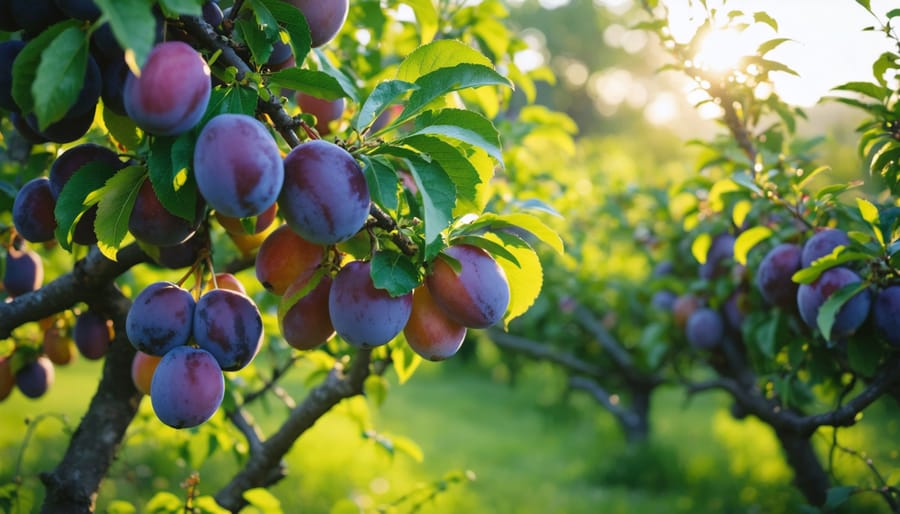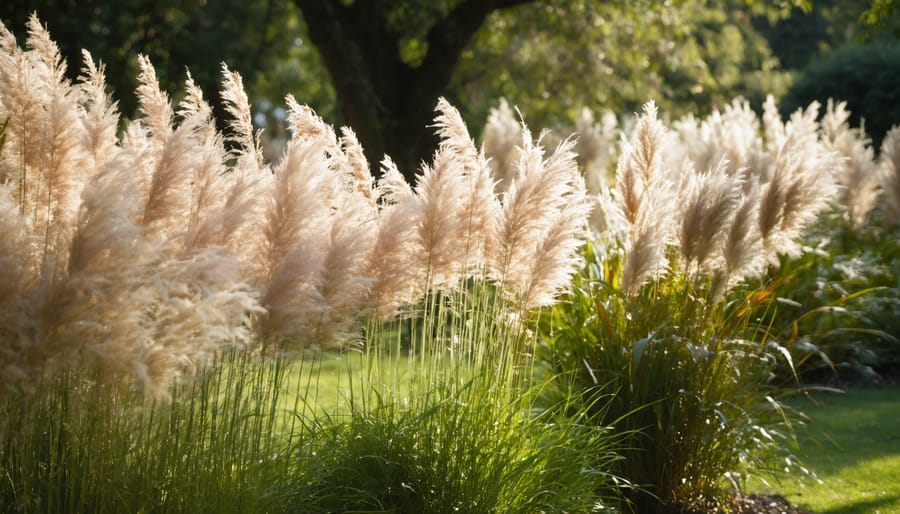Transform your plum tree into a thriving centerpiece of your garden by mastering essential care techniques that maximize fruit production and ensure long-term health. Plant young plum trees in well-draining, slightly acidic soil with full sun exposure, spacing them 15-20 feet apart to allow proper air circulation and growth. Establish a consistent watering schedule that provides 1-2 inches of water weekly during the growing season, adjusting for rainfall and maintaining even soil moisture through proper mulching. Regular pruning in late winter or early spring shapes the tree’s structure, removes damaged branches, and promotes robust fruit development while preventing disease spread. Whether you’re nurturing a single backyard plum tree or managing a small orchard, these foundational care practices create the perfect environment for bountiful harvests and decades of enjoyment. Our comprehensive guide breaks down every aspect of plum tree maintenance, from soil preparation to pest management, ensuring your success as a fruit tree gardener.
Choosing the Perfect Location
Sunlight and Soil Requirements
Plum trees thrive in full sunlight, requiring at least 6-8 hours of direct sun daily for optimal fruit production. While they can tolerate partial shade, you’ll notice fewer fruits and less vigorous growth in shadier spots. When choosing a location, consider the morning sun exposure particularly beneficial, as it helps dry morning dew quickly and reduces disease risks.
For soil requirements, plum trees prefer well-draining, loamy soil with a pH between 5.5 and 6.5. The soil should be rich in organic matter but not waterlogged. Before planting, enrich your soil with compost and ensure at least 18-24 inches of good soil depth for healthy root development. A simple drainage test can help: dig a hole, fill it with water, and if it hasn’t drained within 24 hours, you’ll need to improve drainage with raised beds or soil amendments.
Spacing and Air Circulation
Proper spacing is crucial for healthy plum trees, as it affects both growth and fruit production. For standard-sized plum trees, maintain 20-25 feet between each tree, while dwarf varieties need 12-15 feet of space. This spacing allows roots to spread without competition and ensures each tree receives adequate sunlight.
Good air circulation prevents fungal diseases and promotes better fruit development. When planting, consider the prevailing wind direction and avoid creating dense clusters of trees. Prune regularly to maintain an open center structure, removing any crossing branches or dense foliage that could restrict airflow.
Remember that young trees may look far apart at first, but they’ll fill the space as they mature. It’s better to give them extra room than to crowd them, as cramped conditions can lead to poor harvests and increased pest problems. For urban gardens, consider espalier techniques to maximize space while maintaining good air movement around the trees.
Seasonal Care Calendar
Spring Care Essentials
Spring is the busiest season for plum tree care, and getting it right sets the foundation for a bountiful harvest. Start with pruning in early spring before the buds break, removing any dead, diseased, or crossing branches to improve airflow and sunlight penetration. Make clean cuts at 45-degree angles to prevent water pooling and disease.
Fertilizing is crucial during this time. Apply a balanced, slow-release organic fertilizer around the tree’s drip line, keeping it about 6 inches away from the trunk. Water thoroughly after fertilizing to help nutrients reach the roots. If your soil test indicates specific deficiencies, adjust your fertilizer choice accordingly.
Spring is also prime time for pest prevention. Monitor your tree regularly for signs of common pests like plum curculio and aphids. Installing sticky traps can help catch early infestations, while maintaining a clean garden bed around your tree discourages pest populations. Consider applying organic neem oil as a preventive measure, especially if you’ve had pest issues in previous years.
Remember to keep the area around your tree weed-free and maintain consistent moisture levels as the growing season begins. A layer of organic mulch can help retain moisture and suppress weed growth.
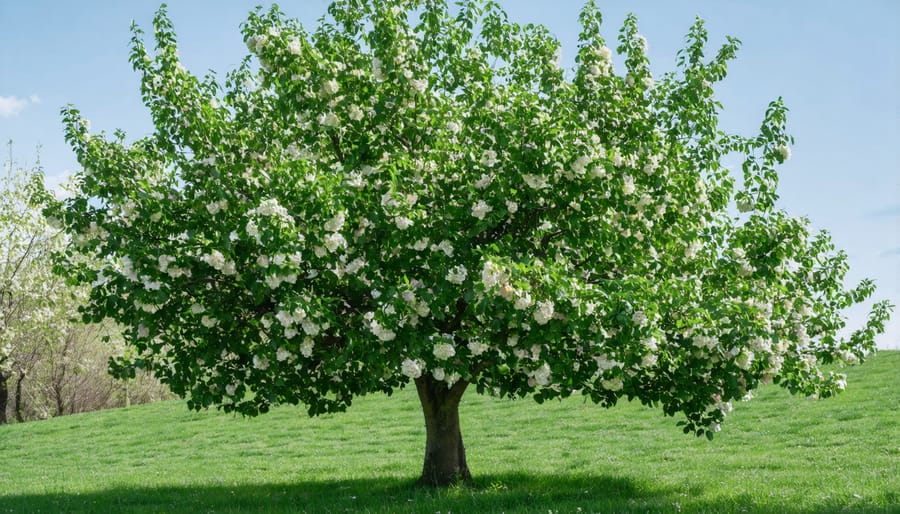
Summer Maintenance
Summer is a crucial time for plum tree care, requiring consistent attention to ensure a bountiful harvest. Water your plum trees deeply but less frequently, aiming for about 1-2 inches of water per week. This encourages deeper root growth and helps prevent fruit splitting. During particularly hot spells, consider adding a layer of organic mulch to retain moisture.
Fruit thinning is essential and should be done when fruits are about the size of cherries. Remove excess fruits, leaving approximately 4-6 inches between each plum. This might seem counterintuitive, but thinning helps produce larger, healthier fruits and prevents branches from breaking under excess weight.
Keep a watchful eye for common summer diseases like brown rot and plum pockets. Check leaves and fruits weekly for any signs of spotting, discoloration, or unusual growth. Remove any infected fruits promptly to prevent disease spread. On humid days, ensure adequate air circulation by keeping the canopy properly pruned.
Consider installing bird netting as fruits begin to ripen, as our feathered friends are particularly fond of sweet, juicy plums. Remember, consistent monitoring and timely intervention are key to maintaining healthy plum trees throughout the summer months.
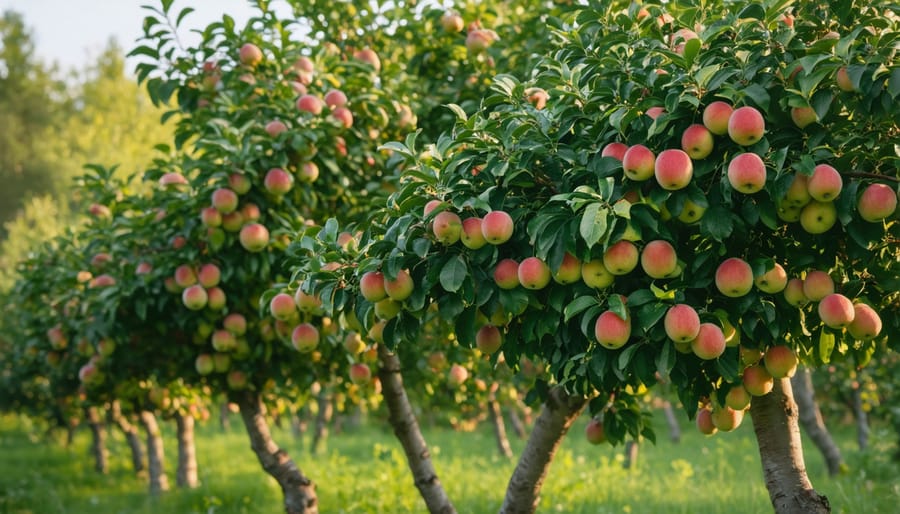
Fall and Winter Protection
As autumn approaches, it’s time to prepare your plum tree for its winter rest. Start by cleaning up all fallen fruit and leaves around the tree to prevent disease. Apply a 3-4 inch layer of organic mulch around the base, keeping it away from the trunk to avoid rot. This insulates the roots and retains moisture during winter months.
For young trees, wrap the trunk with tree guards to protect against winter sunscald and rodent damage. In regions with harsh winters, consider using burlap wrapping for additional protection against freezing winds. Stop fertilizing about six weeks before your first frost date to help the tree enter dormancy naturally.
Monitor for winter damage during the cold season, especially after storms. Remove any broken branches promptly to prevent disease entry points. Keep the tree moderately watered until the ground freezes, ensuring it has enough moisture to survive winter’s dry conditions.
Common Problems and Solutions
Disease Prevention
Keeping your plum trees healthy starts with recognizing early signs of common diseases. Watch out for brown rot, which appears as fuzzy brown spots on fruits, and black knot, characterized by dark, rough swellings on branches. Leaf curl, showing as wrinkled, discolored leaves, can also affect plum trees, especially in wet springs.
Prevention is your best defense. Maintain good air circulation by proper pruning and spacing between trees. Clean up fallen leaves and fruits promptly to prevent disease spread. Apply a dormant spray in late winter to eliminate overwintering fungal spores and insects.
If you spot signs of disease, act quickly. Remove affected branches at least 6 inches below visible infection sites. For fungal infections, use copper-based fungicides early in the growing season. Remember to sanitize your pruning tools between cuts with a solution of one part bleach to nine parts water.
Regular monitoring and maintaining a clean garden environment will help keep your plum trees thriving. Consider companion planting with disease-resistant herbs like garlic or marigolds to naturally deter pests and diseases.
Pest Management
Keeping your plum tree pest-free requires a balanced approach combining prevention and targeted treatments. Common pests like plum curculio, aphids, and fruit moths can be managed effectively through natural pest control solutions before considering chemical options.
Start by encouraging beneficial insects like ladybugs and lacewings, which naturally control aphid populations. Hanging sticky traps can help monitor and reduce fruit moth populations, while regular inspection of fruits and leaves helps catch problems early. For organic control, neem oil spray works wonders against multiple pests while being safe for beneficial insects.
If pest problems persist, consider using insecticidal soaps or targeted chemical treatments as a last resort. Always apply these during evening hours to protect pollinators, and follow package instructions carefully. Remember to maintain good garden hygiene by removing fallen fruit and leaves, which can harbor pests and diseases. Regular pruning to improve air circulation also helps reduce pest problems by creating an environment less favorable to insects and promoting overall tree health.
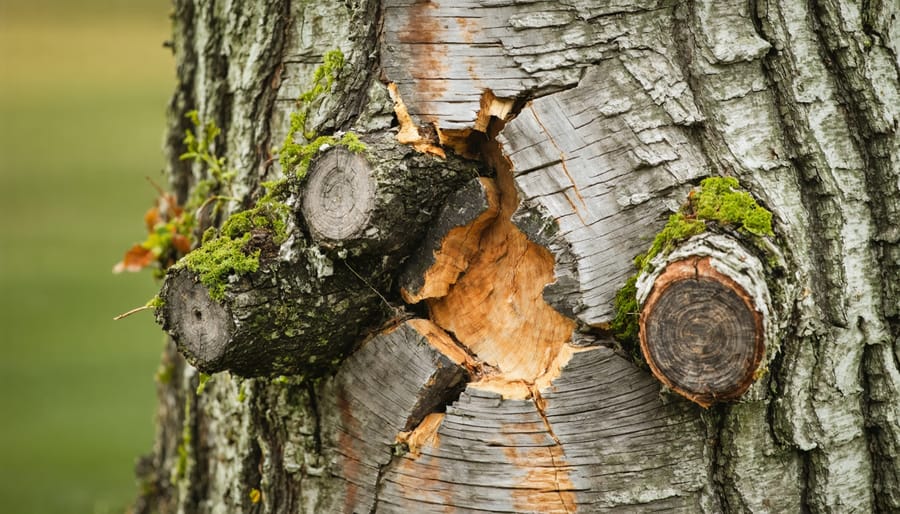
Pruning and Training Tips
Pruning and training your plum tree is a vital skill that can significantly impact its health and fruit production. By following proper pruning techniques, you’ll encourage better air circulation, maximize sunlight exposure, and make harvesting easier.
The best time to prune your plum tree is during its dormant period, typically in late winter or early spring before new growth begins. Start by removing any dead, diseased, or damaged branches, making clean cuts at a 45-degree angle just above a bud. This angle helps water run off and prevents disease from setting in.
For young trees, focus on establishing a strong structure through training. The modified central leader system works well for plum trees. Select 3-5 main branches spaced evenly around the trunk, ideally at a 45-60 degree angle from the trunk. These will become your scaffold branches, supporting future growth and fruit production.
When shaping mature trees, maintain an open-center or vase shape. This allows sunlight to reach all parts of the tree and promotes even fruit development. Remove any branches growing toward the center of the tree, as well as those crossing or rubbing against each other. Aim to keep the tree at a manageable height of 8-10 feet for easier maintenance and harvesting.
Remember the “three D’s” rule: always remove Dead, Diseased, and Damaged branches first. Then focus on Directional pruning to guide growth where you want it. Don’t remove more than 25% of the tree’s live tissue in any one season, as this can stress the tree and reduce fruit production.
For fruit spurs (the short, stubby branches that produce fruit), avoid removing them unless they’re damaged or overcrowded. These valuable branches will continue producing fruit for several years. After pruning, seal any large cuts with tree paint to prevent disease entry and promote healing.
Growing and maintaining a plum tree can be incredibly rewarding, and with the right care approach, you’ll be well on your way to enjoying bountiful harvests of delicious fruit. Remember to focus on providing your plum tree with well-draining soil, adequate sunlight, and consistent watering, especially during the growing season. Regular pruning in late winter or early spring will help maintain the tree’s shape and promote healthy fruit production.
Don’t forget the importance of seasonal care – from spring fertilization to winter protection. By monitoring your tree for signs of pests or diseases and addressing issues promptly, you’ll help ensure its long-term health and productivity. The effort you invest in proper planting, consistent maintenance, and thoughtful care will pay off in years of abundant harvests.
Whether you’re a novice gardener or have years of experience, caring for a plum tree is a wonderful way to connect with nature and enjoy the fruits of your labor. Start implementing these care practices today, and watch your plum tree flourish into a beautiful and productive addition to your garden.

